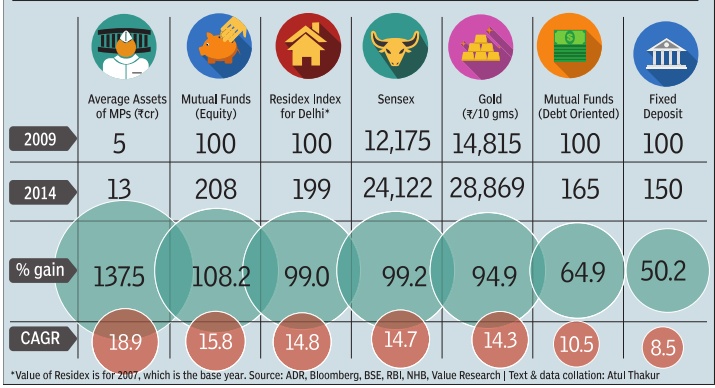Assets of legislators (PM, CMs, Ministers, MPs, MLAs...): India
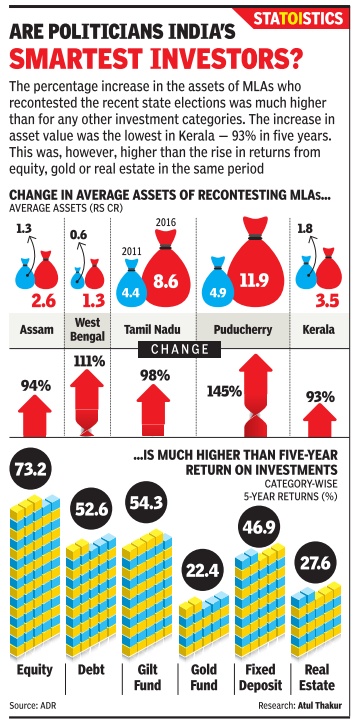
This is a collection of articles archived for the excellence of their content. the Facebook community, Indpaedia.com. All information used will be acknowledged in your name. |
Assets of Chief Ministers
2018: richest, poorest CMs; CMs with criminal cases

The richest and poorest Chief Ministers, in 2018
From: Rumu Banerjee, Chandrababu is richest CM, Manik Sarkar poorest: Report, February 13, 2018: The Times of India
Mamata Has Declared ₹30L Assets
With assets worth Rs 177 crore, Chandrababu Naidu, the chief minister of Andhra Pradesh, is the richest CM in the country. Giving him company in this exclusive club, are the chief ministers of Arunachal Pradesh Pema Khandu, whose assets are worth Rs 129 crore, and Punjab CM, Amarinder Singh, who has Rs 48 crore to his name.
An analysis of the selfsworn affidavits filed by chief ministers of 29 states and two Union Territories throws up interesting facts. Like Mamata Banerjee,CM of West Bengal, has declared assets worth Rs 30 lakh only, with no immovable assets. Devendra Fadnavis, CM of Maharshtra, has the highest number of cases registered against him: 22. Of these, three are serious cases. Coming second is Pinarayi Vijayan, CM of Kerala, who has declared 11 criminal cases against himself in the affidavit. Delhi CM Arvind Kejriwal is a close third with 10 criminal cases registered against his name.
The analysis, which was conducted by transparency body Association of Democratic Reforms (ADR), found that of the 31 CMs, 20 have clean records while 11, or 35%, have declared criminal cases. Eight (26%) have serious criminal cases. The report by ADR also says the average asset per CM is just over Rs 16 crore, with 25 of the 31 CMs being crorepatis.
The three CMs with the lowest assests are Manik Sarkar of CPI(M) with Rs 26 lakh, Banerjee with Rs 30 lakh and Mehbooba Mufti of JKPDP with Rs 55 lakh. The report says that 55% of the CMs have assets worth Rs 1 crore to Rs 10 crore, with 19% having assets less than a crore. 7% have assets worth Rs 100 crore and above.
Education wise, the CMs have a consistent record, with 39% being graduates and another 32% being professionals. A significant 16% are post graduates and 10% have passed high school. One CM, P K Chamling of Sikkim, is a doctorate.
2022-23
U Sudhakar Reddy & Ashok Pradhan TNN, April 13, 2023: The Times of India
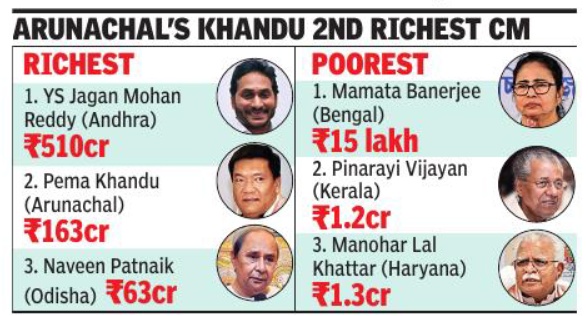
From: U Sudhakar Reddy & Ashok Pradhan TNN, April 13, 2023: The Times of India
Andhra Pradesh CM YS Jagan Mohan Reddy is the richest CM in the country with assets of Rs 510 crore, while West Bengal’s Mamata Banerjee is the only CM who is not a crorepati, Association or Democratic Reforms (ADR), awatch group which works for political and electoral reforms, said in its latest report.
Telangana CM K C Rao tops the list with the highest number of criminal cases and financial liabilities against his name, the report said. Banerjee, with Rs 15 lakh in assets, has the least wealth among all the CMs, followed by Kerala’s Pinarayi Vijayan and Haryana’s M L Khattar,who have Rs 1. 2 crore and Rs 1. 3 crore in assets each, respectively, ADR said.
Details
U Sudhakar Reddy & Ashok Pradhan TNN, April 13, 2023: The Times of India
Out of the 30 chief ministers analysed, 29 (97%) are crorepatis with the average assets for each CM working out to Rs 34 crore, ADR said. ADR filed its report after analysing the poll affidavits of CMs of 28 states and two UTs.
ADR said Arunachal Pradesh’s Pema Khandu trails Jagan with assets worth Rs 163 crore, followed by Odisha CM Naveen Patnaik who has Rs 63 crore in assets. KCR’s assets are worth Rs 23 crore, it said. Patnaik’s assets are largely his immovable properties, around Rs 63. 6 crore of the total Rs 63. 9 crore, the total being around double of the average of assets per CM at Rs 33. 9 crore. The immovable assets of the 76-year-old bachelorpolitician are three properties inherited by him while he has not added any on his own.
In last year’s ADR report, Jagan’s assets stood at Rs 373 crore, including assets he inherited and those he acquired, thereby topping the chart of richest CMs in the country in 2022 as well. KCR had Rs 13. 7 crore in assets last year. Bihar’s Nitish Kumar had Rs 56 lakh, making him one of the “poorest” CMs in the country.
ADR said KCR has 64 criminal cases, including 37 serious offences, against him, making him the CM with the highest number of cases booked against him. A majority of the cases pending against him were booked during the agitation for statehood for Telangana. KCR also faces two charges related to punishment for attempting tocommit offences punishable with imprisonment for life or other jail terms, ADR said. In last year’s report, ADR said KCR was among the five elected representatives in the country to have the highest number of criminal cases (64) booked against him. Kerala MP Dean Kuriakose with 204 cases topped the list, followed by DMK MP S Kathiravan who had 99 cases pending against him.
After KCR, Tamil Nadu CM MK Stalin has the second-highest number (47) of cases pending, including 10 serious offences. Jagan with 38 cases, including 35 serious offences, stood third among CMs with the highest number of cases booked against them. However, none of these cases relate to the most heinous crimes. Out of all 30 CMs analysed, 43% have declared criminal cases against themselves.
2023
Sandeep Moudgal, July 20, 2023: The Times of India
Bengaluru : Karnataka Pradesh Congress Committee (KPCC) president and the state’s deputy chief minister DK Shivakumar is the richest MLA in the country, with assets worth Rs 1,413 crore, according to a report from the Association for Democratic Reforms (ADR) and National Election Watch (NEW).
That’s not all. Karnataka MLAs dominate the list of richest legislators in the country, with 12 in the top 20. ADR report says that 14% of the Karnataka MLAs are billionaires (worth Rs 100 crore), the highest in the country, and the average asset of the legislators is Rs 64.3 crore.
In the list, the top three slots are taken by Karnataka MLAs. The second richest is an independent legislator and businessman KH Puttaswamy Gowda, valued at Rs 1,267 crore and has lia bilities of a mere Rs 5 crore.
The third richest is the youngest Congress MLA in Karnataka assembly Priyakrishna. The 39-year-old has declared assets of Rs 1,156 crore.
The advocacy group has analysed 4,001 sitting MLAs from 28 state assemblies and two Union territories.
In his 2023 affidavit, filed before the Election Commis sion, Shivakumar had disclosed that he has a total of Rs 273 crore in immovable assets and Rs 1,140 crore in movable assets. DKS’s liabilities are Rs 265 crore. Gowda has Rs 990 crore in immovable assets and Rs 276 crore in movable assets.
Interestingly, Priyakrishna also holds the record in the list of legislators from across the country for having the highest liabilities of Rs 881 crore. His father M Krishnappa featured on the list of top billionaires in Karnataka at number 18. The other MLA from Karnataka who is on the list is mining baron Gali Janardhana Reddy at No. 23.
The poorest MLA is Nirmal Kumar Dhara from Indus constituency in West Bengal, with an asset of Rs 1,700 and no liabilities. The poorest MLA who was elected to the Karnataka assembly is BJP’s Bhagirathi Murulya, who has declared assets of Rs 28 lakh and Rs 2 lakh of liabilities.
Assets of Councillors
Delhi
2022
Vibha Sharma & Siddhanta Mishra TNN, Dec 9, 2022: The Times of India
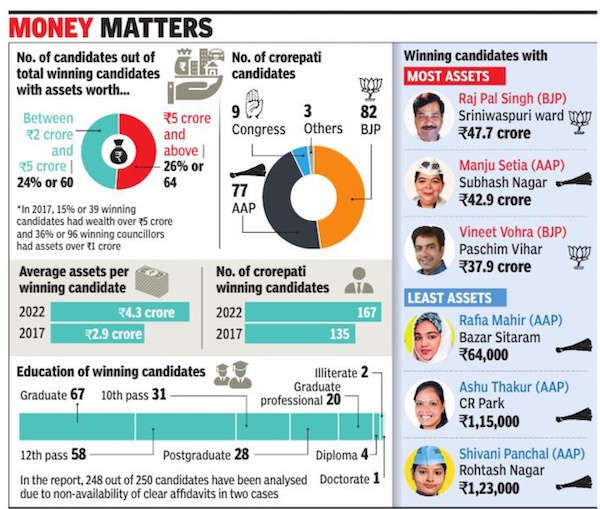
From: Vibha Sharma & Siddhanta Mishra TNN, Dec 9, 2022: The Times of India
See graphic:
Assets of newly elected candidates in Delhi in 2022
New Delhi: This year’s municipal corporation is much richer than the previous one. The civic body has at least 64 newly elected councillors with assets worth over Rs 5 crore compared with 39 in 2017, according to the Association for Democratic Reforms.
An ADR report issued on Thursday said that the average value of the assets held by the winning candidates in the 2022 elections was Rs 4. 3 crore against Rs 2. 9 crore in 2017.
The report said that candidates with wealth totalling Rs 5-10 crore comprise 26% of the new councillors. There are 24% in the Rs 2-5 crore slab and 26% in the Rs 50 lakh-2 crore category. In comparison, in 2017, 36% of the winners had wealth of between Rs 1 crore and Rs 5 crore.
ADR and Delhi Election Watch analysed the selfsworn affidavits of 248 of the 250 councillors who were declared elected to MCD on Wednesday. The assets of two winning candidates couldn’t be studied due to the unavailability of clear and complete affidavits with the State Election Commission of Delhi. ADR also analysed the financial status of all the 1,349 candidates contesting the MCD elections.
Of the 248 winning candidates, 167 (67%) have wealth of above Rs 1 crore.
In 2017, only 135 of 266 councillors analysed, or 51%, were crorepatis.
Among BJP’s 104 candidates who won, 82 (79%) have declared assets worth more than Rs 1 crore, while 77 (58%) of 132 successful contestants from AAP, six (67%) of nine from INC and two of three independents also filed affidavits showing wealth more than Rs 1 crore.
The average assets per winning candidate of the 104 BJP councillors amount to Rs 5. 3 crore, while the same figure for the 132 AAP councillors considered is Rs 3. 6 crore, the report said. The average asset value per candidate for the nine Congress councillors is Rs 4. 1 crore and Rs 5. 5 crore for the three independent councillors.
A member of ADR said, “While the role of money in our elections is evident from the fact that all major political parties gave tickets to wealthy candidates, the election results also showed that chances of winning elections are high when the candidate is financially strong. ”
The winning candidate with assets of the highest worth is Raj Pal Singh of BJP, who won from Sriniwaspuri. He had a declared wealth of more than Rs 47. 7 crore. Manju Setia of AAP, winner from Subhash Nagar, followed Singh in terms of asset value with Rs 42. 9 crore, while Vineet Vohra of BJP, the victorious candidate from Pachim Vihar, is third in the list with total assets of Rs 37. 9 crore.
Singh, who beat AAP candidate Indu by a margin of 1,703 votes, said on Thursday that wealth had nothing to do with winning elections. “It is performance that is considered by voters,” he said. “I made sports complexes and recreation centres in my wards even when there were budget constraints in the corporation. I never disappointed anyone in the last five years irrespective of the political party he or she supported,”said Singh.
Meanwhile, none of the top three wealthiest contestants could beat their rivals. Ram Dev Sharma of BJP and contesting the Ballimaran seat has wealth totalling Rs 66. 9 crore. Nandini Sharma of BJP in Malviya Nagar had declared assets of Rs 49. 8 crore and AAP’s Jitender Bansala in Karawal Nagar-West, Rs 48. 2 crore.
[
Assets of LS candidates
2019

Their assets,
Criminal cases against them,
Women candidates
From: Rumu Banerjee, May 14, 2019: The Times of India
See graphic:
Candidates for the 2019 LS polls:
Their assets,
Criminal cases against them,
Women candidates
Assets of MLAs/ MLCs
Karnataka
2013-18: 64% rise
The report by the Association for Democratic Reforms (ADR) further revealed that the five richest, with more than Rs 100 crore addition in their wealth since the last elections, belonged to the ruling Congress party.
An analysis of the the self-sworn affidavits of the 184 MLAs , who are recontesting the Karnataka Assembly elections on May 12, shows that they have seen a 64 per cent growth in their assets as compared to the 2013 elections, according to an ADR report.
The report by the Association for Democratic Reforms (ADR) further revealed that the five richest, with more than Rs 100 crore addition in their wealth since the last elections, belonged to the ruling Congress party.
The five richest MLAs in the fray, who saw more than Rs 100 crore increase in their assets include D.K. Shivakumar, N. Nagaraju, Shamanur Shivashankarappa, Priyakrishna and Deshpande Raghunath Vishwanath -- all from the Congress.
The average assets of these 184 re-contesting MLAs from various parties, including independent MLAs, in 2013 was Rs 26.92 crore, which have grown to Rs 44.24 crore now. This shows an increase of Rs 17.31 crore in the average assets.
D.K. Shivakumar had declared assets worth Rs 251 crore in 2013, which grew to Rs 840 crore now, an increase of Rs 588 crore (or 234 per cent).
N. Nagaraju had declared assets worth Rs 470 crore in 2013, which have now grown up to Rs 1,015 crore (116 per cent rise). Shamanur Shivashankarappa 's assets worth Rs 67 crore in last elections have increased to Rs 183 crore (170 per cent rise).
Priyakrishna had assets worth Rs 910 crore in 2013 which have now become Rs 1,020 crore (12 per cent rise) while Vishwanath's assets have risen from Rs 113 crore in the last polls to Rs 215 crore now (or 89 per cent).
The 108 recontesting MLAs of the Congress have seen an average of 66 per cent rise in their assets since 2013 while the 49 recontesting MLAs of the Bharatiya Janata Party (BJP) have seen an average increase of 65 per cent in their assets.
The 24 recontesting MLAs of the Janata Dal-Secular (JD-S) have seen an increase of 50 per cent in their assets, the analysis showed.
MLAs/ 2018
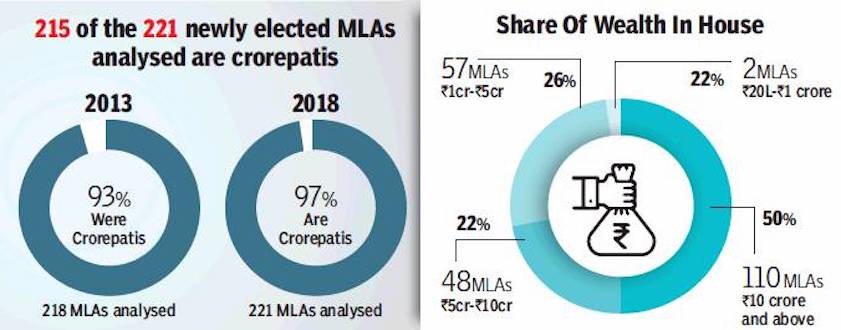
From: May 17, 2018: The Times of India
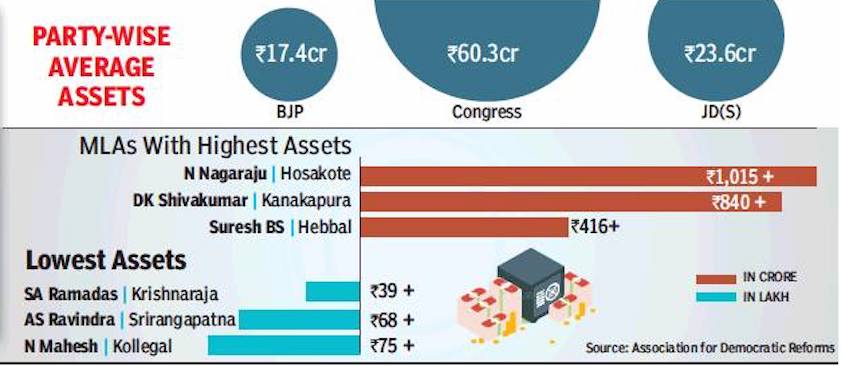
From: May 17, 2018: The Times of India
See graphics:
The assets of Karnataka MLAs- 2018 (I)
Meghalaya, Nagaland, Tripura: 2018- 22
Gilles Verniers and Ananay Agarwal, March 14, 2023: The Times of India

From: Gilles Verniers and Ananay Agarwal, March 14, 2023: The Times of India
Elections in the NorthEast used to be an economical affair, compared to the rest of the country where parties and candidates tend to
splurge vast sums of money to contest. The intensification of competitiveness of elections and the involvement of new parties in state elections have somewhat changed that feature of politics in the North-East. Here, we compare the average net assets of major parties’ candidates and MLAs across the three states that just went to the polls.
In Tripura, the average self-declared wealth of MLAs has increased from Rs 26 lakh in 2008 to Rs 1. 5 crore in 2023. In Nagaland, MLAs went from declaring an average of Rs 4 crore net assets in 2008 to nearly Rs 9 crore in 2023. The rise is even more pronounced in Meghalaya, where MLAs declared on average Rs 1. 1 crore of assets in 2008, against Rs 9. 1 crore in 2023.
This is not a proxy measure for how much parties spend in their elections in these states. But it shows that parties tend to recruit increasingly wealthy candidates. The question is to see whether certain parties are more responsible than others for these upward trends.
In Meghalaya, in 2023, the two main parties of the governing coalition, NPP and UDP, nominated on average wealthier candidates than their opponents (around Rs 10 crore of average assets for both parties). The 11 UDP candidates who won are twice as rich on average as the 34 UDP candidates who lost (Rs 15. 2 crore against Rs 7. 2 crore).
The variations are stark among MLAs of the same party as well. The richest UDP MLA, who is also the richest winner across parties, is Metbah Lyngdoh, from Mairang (ST) seat. He declared Rs 146 crore of assets against his party colleague Nujorki Sungoh, Mowkaiaw MLA, who declared merely Rs 18 lakh assets.
NPP winners had below average assets compared to NPP candidates, while the two BJP candidates who won are among the richest candidates fielded by their party (one worth Rs 16 crore and the other Rs 13 crore).
In Nagaland, the NDPP fielded the richest candidates, and got elected the richest MLAs, on average. Among the three other parties, there isn’t much differentiation. NPF and NPP winners, however, tend to be twice as rich as their losing counterparts. Here again, there are variations. The Kohima Town MLA, Dr Tseilhoutuo Rhutso, is worth Rs 22 crore, against Rs 84 lakh of assets declared by Seyochung Sitimi MLA C Kipili Sangtam.
In Tripura, BJP and Congress candidates are significantly richer than their regional and local opponents. The six candidates of the Indigenous People’s Front of Tripura are the only ones particularly abstemious in that regard. The wealthiest MLA in the new Tripura assembly is chief minister Manik Saha from Town Bordowali (Rs 13 crore).
What these data, which have an indicative value, reveal is that national parties, or more specifically BJP, are not solely responsible for recruitment of wealthier candidates. Regional parties contribute to that phenomenon as well, with the exception of Tripura. It is possible then the nomination of wealthier candidates by national parties encouraged regional and local parties to imitate them, in order to resist their competitive pressure. It is more likely however that this upward trend reveals broader transformations of politics in the North-East, which has become more attractive for wealthier individuals.
We do not have a lot of reliable information on the occupational background of these states’ MLAs. In Meghalaya, 38 of the 59 MLAs declared politics or social service as their profession. In Nagaland, 40 of the 60 MLAs declared the same. In Tripura, the count is 39 of 60. This dedication to social service and politics seems at odds with the evolution of the wealth of elected representatives in these three states. We know ‘politician’ or ‘social worker’ are often generic labels that obfuscate elected representatives’ actual source of income.
For a long time an exception among Indian states, electoral politics in the North-East is now following a trend observable across India, which is the growth of a political class that is more and more elitist in class terms. This has an adverse effect on the representative character of assemblies, which tend to exclude the poor or even middle-class candidates.
The data shows that there are still variations and that non-wealthy candidates still succeed in getting elected in these three states. But they are fewer and fewer and it is becoming more and more difficult to enter politics and survive in it without personal wealth.
Gilles Verniers is director and Ananay Agarwal, lead researcher, Trivedi Centre for Political Data. Puneet Arya contributed to the data. Views are personal
2018: Indian MLAs’ incomes

From: September 18, 2018: The Times of India
See graphic:
The average income of MLAs in India, region-wise, presumably in 2018
Personal incomes
MLAs have average annual income of ₹25 lakh: Study, September 18, 2018: The Times of India
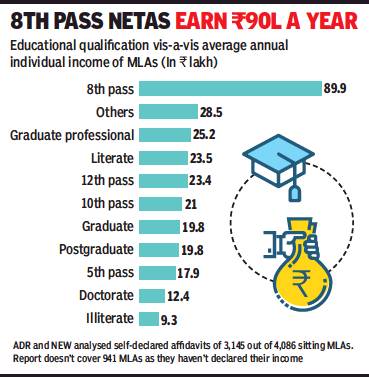
From: MLAs have average annual income of ₹25 lakh: Study, September 18, 2018: The Times of India
Karnataka MLAs Richest, Those From East Earn The Least
The average annual income of MLAs in India is Rs 24.59 lakh, with Karnataka’s 203 MLAs reporting the highest average of Rs 111 lakh and 614 MLAs from the eastern region the lowest at Rs 8.5 lakh annually.
The income analysis released by ADR and National Election Watch (NEW) on Monday show 63 MLAs of the Chhattisgarh assembly have the lowest annual average income at Rs 5.4 lakh. On the whole, 711 MLAs from the southern states declared the highest average annual income of Rs 51.99 lakh.
The usually close relation between college degrees, particularly at the postgraduate level, and higher incomes is missing when it comes to MLAs. The self-declared affidavits of 3,145 of a total 4,086 MLAs shows that 33% of MLAs — who were between Class 5 and Class 12 pass — averaged an annual income of Rs 31.03 lakh while 63% ‘graduate and above’ MLAs earned Rs. 20.87 lakh.
The average annual income of ‘illiterate’ MLAs was Rs 9.3 lakh. The report said 941 MLAs did not declare their income and thus were not analysed. ‘Housewife’ MLAs had the lowest average annual self-income of Rs 3.79 lakh.
Asked why less-educated MLAs are earning more than those with college and professional degrees, ADR foundermember Jagdeep Chhokar said higher educational level is not necessarily a guarantor of higher income.
Prof Chhokar said many high-income MLAs declared agriculture as their profession. “This is largely because agricultural income is taxfree and they don’t have to explain where their income has come from,” he said.
The ADR analysis shows MLAs engaged in business or agriculture had an annual average income of Rs 57.81 lakh. MLAs in real estate business or acting and filmmaking, who together comprised 1% of the total MLAs analysed, had an average annual income of Rs 39 lakh and Rs 28 lakh respectively.
The richest MLA, N Nagaraju representing Bangalore (Rural), declared an annual income of Rs 157.04 crore, while the MLA with lowest annual income of Rs 1,301 was B Yamini Bala from Andhra Pradesh.
The average annual income of 1,402 MLAs between 25-50 years was Rs 18.25 lakh, while that of 1,727 MLAs between 51-80 years was Rs 29.32 lakh. Interestingly, 1
Chhattisgarh, Madhya Pradesh, Rajasthan, Telangana: 2023
See graphic:
Chhattisgarh, Madhya Pradesh, Rajasthan, Telangana: The assets of newly elected MLAs, 2023
Assets of ministers
Karnataka
2018- 23
Akram M, April 15, 2023: The Indian Express
The fortunes of five ministers in the Basavaraj Bommai-led BJP government in Karnataka and their spouses have seen a marked rise from 2018, according to affidavits they filed ahead of the May 10 Assembly elections.
The ministers whose assets have increased substantially are Minister for Medical Education and Health and Family Welfare, K Sudhakar; Minister of Power V Sunil Kumar; Minister for Public Works Department C C Patil; Minister of State for Cooperation ST Somashekhar; and Industries Minister Murugesh Nirani.
As per property details submitted in the affidavits to the State Election Commission, the movable assets of Sudhakar, who was also among the 17 rebels who defected to the BJP in 2019, saw an increase from Rs 1.11 crore in 2018 to Rs 2.79 crore in 2023. Immovable assets remained almost the same during the period.
Sudhakar’s wife Dr Preethi GA saw a huge surge in her immovable assets, which went from Rs 1.17 crore in 2018 to Rs 16.1 crore in 2023. This includes the purchase of a house worth Rs 14.92 crore in Bengaluru’s Sadashivanagar last September.
The movable assets of Somasekhar, one of the rebels in 2019, saw an eight-time surge from Rs 67.83 lakh in 2018 to Rs 5.46 crore. Kumar’s movable assets, on the other hand, went up three-fold from Rs 53.27 lakh in 2018 to Rs 1.59 crore in 2023. Immovable assets grew two-and-half times from Rs 1.68 crore to Rs 4.03 crore in the same period.
Nirani’s movable assets went from Rs 16 crore to Rs 27.22 crore, while his immovable assets shot up from Rs 4.58 crore to Rs 8.6 crore over the last five years. His wife Kamala Nirani saw her movable assets rise from Rs 11.58 crore in 2018 to Rs 38.35 crore.
Patil’s movable assets grew from Rs 94.36 lakh in 2018 to Rs 3.28 crore, while his immovable assets went from Rs 4.47 cr to Rs 7.2 crore during this five-year period.
Affidavits
K Sudhakar
2023
Movable assets – 2.79 crore (wife Dr Preethi GA 6.59 crore) Immovable – Rs 2.66 crore (wife 16.1 crore, includes a 14.92 crore Sadashivanagar house bought on Sep 1, 2022) Liabilities – Rs 1.6 crore (wife 19.06 crore)
2018
Movable – Rs 1.11 crore (wife 10.76 crore) Immovable – Rs 2.34 cr (1.17 crore) Liabilities – Rs 15.94 lakh (wife Rs 10.7 crore) —————————-
Murugesh Nirani
2023
Movable assets – Rs 27.22 crore (Wife Kamala Nirani 38.35 crore) Immovable – Rs 8.6 crore (23.85 crore) Liabilities – Rs 22.62 crore (47.56 crore)
2018
Movable – Rs 16 crore (wife 11.58 crore) Immovable – 4.58 crore (20.3 crore) Liabilities – Rs 8.31 crore (15.23 crore) ————— ————
CC Patil
2023
Movable assets – Rs 3.28 crore Immovable – Rs 7.2 crore Liabilities – Rs 3.22 crore
2018
Movable – 94.36 lakh Immovable – 4.47 crore Liabilities – 1.09 crore
————— ————
V Sunil Kumar
2023
Movable assets – Rs 1.59 crore (wife 1.42 crore) Immovable – Rs 4.03 crore Liabilities – Rs 45.15 lakh
2018
Movable – Rs 53.27 lakh (62.29 lakh) Immovable – Rs 1.68 crore Liabilities – Rs 69.43 lakh ———————————
ST Somashekar
2023
Movable assets – Rs 5.46 crore Immovable – Rs 8.91 crore Liabilities – Rs 1.22 crore
2018
Movable – Rs 67.83 lakh Immovable – Rs 8.14 crore Liabilities – Rs 92 lakh
Assets of municipal councillors
Delhi: 2022
Dec 1, 2022: The Times of India
New Delhi : Out of the 84 former councillors contesting in this MCD elections, the assets of 75 have increased from 3% to 4,437% in the past five years, claimed an Association for Democratic Reforms (ADR) report.
“The ADR and Delhi Election Watch have analysed the self-sworn affidavits of 84 recontesting councillors and the average asset growth for them, between the MCD elections of 2017 and 2022, is Rs 1. 44 crore or 49%. In the 2017 elections, the average asset of these councillors was Rs 2. 93 crore; in 2022, their assets have increased to Rs 4. 37 crore,” stated the report.
Among the first five councillors with the highest asset increase, Vineet Vohra, the 2017 BJP councillor from Pachim Vihar, is at the top. “He declared a maximum increase of Rs 28. 61 crore in assets, from Rs 9. 33 crore in 2017 to Rs 37. 94 crore in 2022. At second number is Nandini Sharma, 2017 BJP councillor from Malviya Nagar. Her assets have increased by Rs 25. 58 crore, from Rs 24. 25 crore in 2017 to Rs 49. 8 crore in 2022. At third position is Shikha Roy, 2017 BJP councillor from Greater Kailash. Her assets have risen by Rs 6 crore, from Rs 6. 8 crore in 2017 to Rs 12. 8 crore in 2022,” stated the report. Inderjeet Sehrawat, the 2017 BJP councillor from Mahipalpur, is at the fourth position, while the ex-Karawal Nagar councillor, BJP’s Puneet Sharma, is at the fifth position. “While Sehrawat’s assets have grown by Rs 4. 4 crore from Rs 3. 9 crore in 2017 to Rs 8. 3 crore in 2022, Sharma’s assets have grown by Rs 3. 69 crore from Rs 4 crore in 2017 to Rs 7. 79 crore in 2022,” stated the report.
The others in the list included Mandeep Singh, Congress ex-councillor from Lakshmi Park, BJP’s Shyam Kumar Mishra from Mohan Garden South and AAP’s Ashok Kumar from Shakur Pur.
The party-wise average increase included 49% for BJP, 36% for AAP and 59% for Congress, the report stated. The councillors included 53 from BJP, 22 from AAP, five from Congress and four Independents.
The assets of nine re-contesting councillors have decreased by -2% to -76%, it stated.
Assets of MPs
India
2009-14
Sharp rise in the value of the assets of MPs
STATISTICS - ARE OUR NETAS FINANCIAL WHIZKIDS?
The Times of India Jul 20 2014
See the chart on this page: The growth in the value of the assets of Indian Members of Parliament (2009-14) was higher than the growth in the value of mutual funds, gold or Delhi property.
2022
U Sudhakar Reddy, Sep 13, 2023: The Times of India
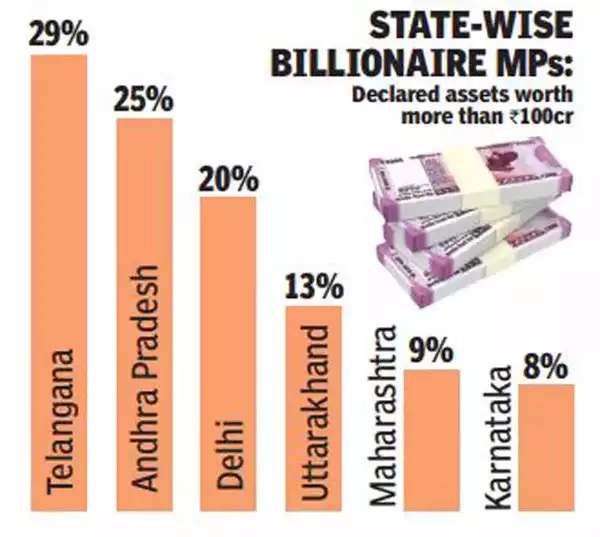
From: U Sudhakar Reddy, Sep 13, 2023: The Times of India
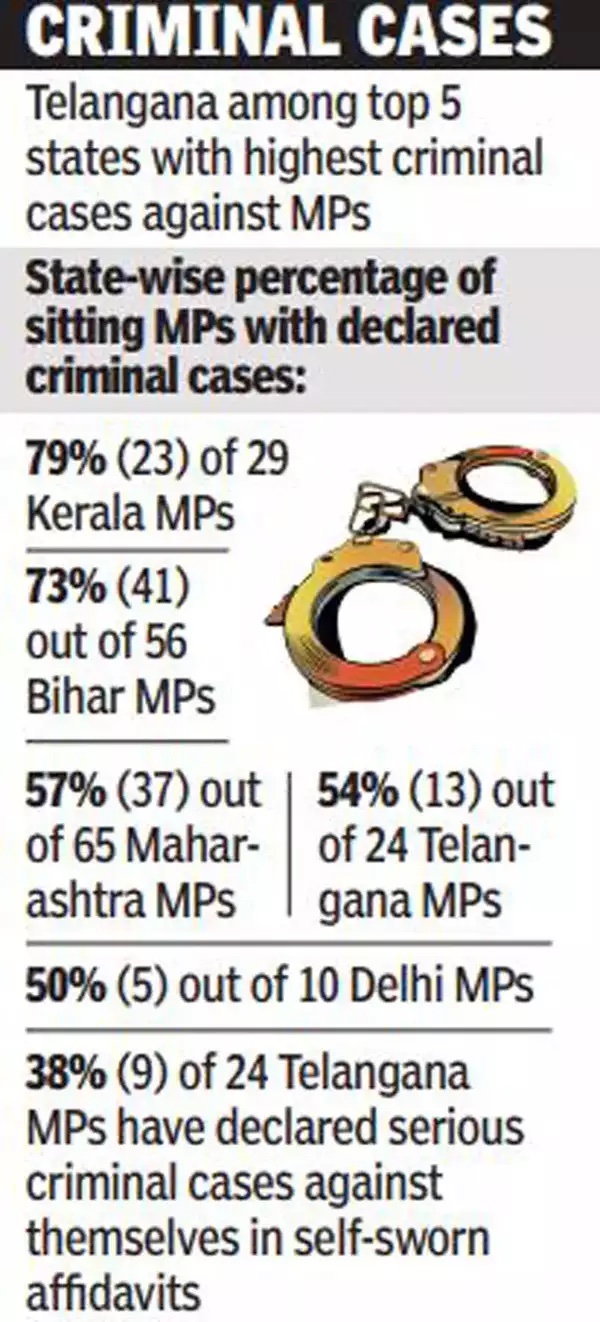
From: U Sudhakar Reddy, Sep 13, 2023: The Times of India
HYDERABAD: An analysis of assets of 763 sitting MPs out of 776 seats of Lok Sabha and Rajya Sabha across the country by Association for Democratic Reforms (ADR) and National Election Watch (NEW) revealed that Telangana has the most billionaire MPs in the country.
Assets | Telangana has most billionaire MPs in country, with highest assets
Total assets of 24 Telangana MPs | Rs 6,294cr
Total assets of 36 Andhra Pradesh MPs | Rs 5,427cr
MPs with highest assets :
Bandi Parthasaradhi Reddy (BRS) | Telangana - Rs 5,300cr
Alla Ayodha Rami Reddy (YSRCP) | AP - Rs 2,577cr
Party-wise billionaire MPs
44% (7) of 16 BRS MP
23% (7) of 31 YSRCP MPs
4% (14) of 385 BJP MPs
7% (6) of 81 INC MPs
Average assets of 16 BRS MPs: Rs 383cr
Average assets of 31 YSRCP MPs: Rs 153cr
Total assets of 763 sitting MPs in country: Rs 29,251cr
Andhra Pradesh
2022
Umamaheswara Rao, August 20, 2023: The Times of India
Visakhapatnam : About 45% (5 out of 11) of Rajya Sabha MPs from Andhra Pradesh are billionaires, according to an analysis by the Association for Democratic Reforms (ADR). This is the highest for any state in the country.
According to ADR’s report, prepared based on election affidavits submitted by candidates, the nine YSRCP Rajya Sabha MPs declared assets worth Rs 3,561 crore, which is the second-highest for any political party in the country. The seven Bharat Rashtra Samithi (formerly Telangana Rashtra Samithi) parliamentarians accounted for assets worth Rs 5,596 crore to clinch the top spot among all political parties.
YSRCP MP Alla Ayodhya Rami Reddy, with Rs 2,577 crore in assets, is the second-richest Rajya Sabha MP in the country, trailing only Dr Bandi Partha Saradhi from Telangana (Rs 5,300 crore). Reddy declared Rs 154 crore worth of liabilities. The total assets of 11 MPs from Andhra Pradesh is Rs 3,823 crore, placing AP in second place among states with the highest total assets of sitting Rajya Sabha MPs. Telangana outscored AP with its Rajya Sabha MPs declaring combined assets of Rs 5,596 crore.
About 36% (4 out of 11) of Andhra Pradesh MPs from the Upper House have criminal cases against them. Of the four, three belong to YSRCP.
Court verdicts/ pronouncements
SC: Why no rule for assets disclosure by candidates?/ 2019
Intending to make it tough for the corrupt to contest polls, the Supreme Court asked the Centre why it had not amended the Conduct of Election Rules, as per the SC’s 2018 ruling, for compulsory disclosure of assets and sources of income of candidates, spouses and dependants while filing nomination.
Though NGO ‘Lok Prahari’ had sought initiation of contempt proceedings, a bench of CJI Ranjan Gogoi and Justices Deepak Gupta and Sanjiv Khanna decided to direct the secretary of legislative department in the Union law ministry to explain why it had failed to implement a series of directions issued by the apex court in its February 16, 2018 judgment intending to empower voters to make an infor med choice.
Details of netas’ assets must be in public domain: SC
The first question asked by the CJI-led bench was why the government had not set up a permanent mechanism, as ordered by the Supreme Court in 2018, to investigate any unnatural increase in the assets of a legislator or their spouses and dependants during their tenure as member of the House.
Last year, the SC had said, “Increase in assets of legislators and/or spouses or dependants disproportionate to their known sources of income is, by compelling inference, a constitutionally impermissible conduct and may eventually constitute offences punishable under PC Act.
“It is necessary to have a permanent mechanism dedicated to the task. Such mechanism is required to periodically collect data of legislators and their respective spouses and dependants and examine in every case whether there is a disproportionate increase in the assets and recommend action in appropriate cases either to prosecute the legislator or her/his spouse and dependants or place information before appropriate legislature to consider eligibility of such legislators to continue to be members of the concerned House.”
It had said such data should also be put in the public domain to enable voters to take an informed decision, if the legislator chose to contest again.
The SC had also asked why a clause was not added to the affidavit to be filed by candidates requiring him/her to give an undertaking that he/ she was not disqualified to contest under any of the provisions of the Representation of the People Act and the Conduct of Election Rules. The CJI-led bench asked the legislative secretary why rules were not amended to implement that part of the 2018 judgment which directed that nondisclosure of assets and sources of income of candidates, their spouses and dependants would constitute corrupt practices. The 2018 judgment had said, “Non-disclosure of assets and sources of income of the candidates, their spouses and dependants would constitute a corrupt practice falling under the heading ‘undue influence’ as defined under Section 123(2) of RP Act, 1951.”
Discrepancies between income and assets
2017: Income, assets of MPs don’t match
HIGHLIGHTS
The revelation came in the affidavit filed by the CBDT in response to a petition filed in 2015 by NGO “Lok Prahari".
The NGO had submitted a list of 26 Lok Sabha MPs, 11 Rajya Sabha MPs and 257 MLAs to the tax department seeking verification of their election affidavits.
Property of 7 MPs and 98 MLAs under the scanner of Income Tax department.Property of 7 MPs and 98 MLAs under the scanner of Income Tax department.
NEW DELHI: The Central Board of Direct Taxes (CBDT) informed the Supreme Court that it had found discrepancies between the incomes and assets of several MLAs and a few MPs after verification of their election affidavits.
Referring to assets declared in election affidavits by seven Lok Sabha members and 98 MLAs, the CBDT said, "Verification prima facie with known sources of income has indicated discrepancy and, therefore, these are taken up for further investigation which may include reference to the assessing officer for making assessment."
This revelation came in the affidavit filed by the CBDT in response to a petition filed in 2015 by NGO "Lok Prahari", which had submitted a list of 26 Lok Sabha MPs, 11 Rajya Sabha MPs and 257 MLAs to the tax department seeking verification of their election affidavits while alleging substantial increases in their assets compared to the asset details given by them in previous election affidavits. It had alleged in the SC that the CBDT was taking no action on the information given to the tax department. Seen along with the a development on Friday, when the SC took up a petition for scrutiny and sought the response of the Election Commission and the Union government on a plea for a mechanism to provide for penal consequences for candidates giving false information in election affidavits, the two rulings of the apex court in a space of four days will have a significant impact on making elections fair and transparent.
In the Lok Prahari case, the CBDT said it had entered into an agreement with the EC on verification of asset details of candidates submitted in election affidavits. The categories of affidavits which would be verified are specific cases referred by the EC; cases of phenomenal growth in assets compared to the details given in previous affidavit; cases of winning candidates and veracity of the affidavits compared to the returns of income filed by them; instances where there was no PAN but movable and immovable assets disclosed were in excess of Rs 5 crore; and cases where new immovable assets above a threshold of Rs 2 crore were found compared to the last affidavit.
The CBDT will provide the names of the MPs and MLAs found to have amassed assets disproportionate to their income in a sealed cover on Tuesday to a bench headed by Justice J Chelameswar.
On the list of MPs and MLAs submitted by Lok Prahari to the tax department for verification, the CBDT said in the case of nine Rajya Sabha MPs and 42 MLAs, "the verification reports from Director General of Income Tax are pending". It said no discrepancy was found in affidavits filed by nine Lok Sabha MPs, two Rajya Sabha MPs and 117 MLAs.
Explaining its role in verification of election affidavits, the CBDT said, "Given that revenue augmentation is the primary concern of the income tax department, and since increasingly the department is graduating towards non-intrusive methods, the verification of election affidavits is carried out in respect of specific category of such cases, as per agreed parameters between EC and CBDT".
Investments
What politicians invest in/ 2019
April 28, 2019: The Times of India
What politicians invest in: Mutual funds, Reliance shares, even Kingfisher Airlines
NEW DELHI: Fixed deposits and tax-free bonds seem to be among the most favoured financial investments for the political leaders fighting the 2019 Lok Sabha polls, while mutual funds and stocks also adorn the portfolios of many and some even have got shares of long-defunct firms like Kingfisher Airlines.
Shares of Mukesh Ambani-led Reliance Industries Ltd (RIL), the country's most valued company with a market capitalistion of over Rs 8.82 lakh crore, can be found in the portfolios of several leaders, while stocks and mutual fund units of the firms from younger brother Anil Ambani-led Reliance Group are also a common sight, as per disclosures made in election affidavits of the contestants.
However, some top leaders including Prime Minister Narendra Modi have no stock market or mutual fund exposure at all and their financial savings are limited to deposits in banks, tax-free bonds, insurance policies and instruments like National Savings Certificate.
The direct equity investments for a few are limited to unlisted companies, including those owned by their families.
BJP President Amit Shah has disclosed a long list of listed and unlisted shares in his name and in the name of his spouse. The listed shares in his name, totalling over Rs 17.5 crore, include companies from Aditya Birla Group, Bajaj, L&T, Tata and both Reliance groups, as also several PSUs.
Congress chief Rahul Gandhi has disclosed equity holding in Young Indian and investments in several mutual funds. The portfolio of his mother and senior party leader Sonia Gandhi includes equity shares of Young Indian and Maruti Technical Services Pvt Ltd and mutual fund units of HDFC, Kotak, Motilal Oswal and Reliance MF.
NCP's Supriya Sule, daughter of veteran leader Sharad Pawar, has got unlisted shares worth over Rs 1 crore and listed shares worth over Rs 6 crore, besides some mutual funds.
The listed shares include those of Adani Group firms, the two Reliance groups, several Tata firms and even Kingfisher Airlines as also of some other companies from the erstwhile UB Group, including United Spirits which was sold by defaulter businessman Vijay Mallya to global liquor giant Diageo Plc.
Kingfisher shares have long been delisted from the stock exchanges, though they quoted at above Rs 300 apiece once. The stocks eventually slipped below Re 1 and trading was eventually suspended in 2014-end after mounting troubles for the erstwhile luxury airline had led to its closure.
Union minister and BJP candidate from Nagpur Nitin Gadkari has equity shares of Purti Power and Sugar Ltd, among other investments.
Poonam Mahajan, BJP candidate from Mumbai North Central, has disclosed listed equity investments by her spouse in Kingfisher Airlines, as also in Reliance Industries, TCS, Vodafone Idea Cellular and Reliance Power.
Her Congress rival Priya Dutt has listed several mutual fund and portfolio schemes totalling about Rs 14.92 crore, while the listed shares disclosed in the name of her spouse include Reliance Industries, Reliance Infra and Reliance Power.
Congress candidate from Mumbai South, Murli Deora, has disclosed multiple bonds, structured market products, PMS account, mutual funds and FMPs (fixed maturity plans).
Actress-turned-politician Urmila Matondkar, Congress candidate from Mumbai North, has disclosed Rs 28.28 crore worth investment in shares, bonds and mutual funds and PMS (portfolio management service) investments worth about Rs 6 crore, but the individual stocks/units were not disclosed.
Jaya Prada, another former actress and the BJP candidate from Rampur in Uttar Pradesh, has also disclosed investments in some listed companies such as Energy Development Company Ltd (which has got her political mentor Amar Singh as a promoter), Coal India, HDFC Bank, ITC, MCX and Reliance Industries.
Actor-politician Raj Babbar, the Congress candidate from Fatehpur Sikri, has investments in IL&FS Transportation Networks Ltd.
Among other Uttar Pradesh candidates, Union minister and BJP leader Satyapal Singh has disclosed investments worth Rs 1.5 lakh in mutual funds and bonds in his name and some equity shares held by his spouse including of Reliance Capital and Reliance Industries.
Another union minister V K Singh and his spouse have also invested in various mutual funds.
Richest MPs
2019-2024
April 10, 2024: The Times of India

From: April 10, 2024: The Times of India
The data presents the absolute number of Lok Sabha members in various states who declared assets worth more than ₹100 crore in their affidavits for the 2019 general election. The ranking is based on each state’s billionaire MPs as a percentage of its total MPs.
Wives’ incomes
2018: Wives of top MP politicians earn more than husbands
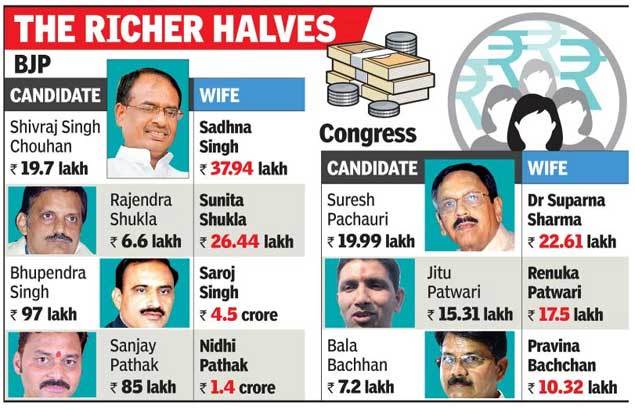
From: Amarjeet Singh, Madhya Pradesh assembly elections: Neta wives have heavier money bags, November 10, 2018: The Times of India
When it comes to purse power, it’s wives of Madhya Pradesh’s heavyweight politicians who tip the scales. Affidavits filed before Election Commission show that wives of more than half of the prominent leaders, from either side of political divide, earn more than their husbands.
This includes chief minister Shivraj Singh Chouhan, whose wife Sadhna Singh has an annual income of Rs 37 lakh — nearly twice as that of her husband’s (Rs 19.7 lakh). In the last election, Chouhan had said that his post-tax income was Rs 17.12 lakh while Sadhna Singh’s was Rs 20.5 lakh.
Minister Bhupendra Singh’s wife has an annual income of Rs 4.5 crore, while he has an annual income of only Rs 97 lakh. The same goes for the wife of minister Rajendra Shukla — his affidavit shows an annual income of only Rs 6.6 lakh while his wife’s is Rs 26.66 lakh per annum. The wife of minister Sanjay Pathak, who switched from Congress to BJP after the 2013 polls, earns Rs 1.4 crore compared to Pathak’s annual income of Rs 85 lakh.
The same trend is seen in heavyweight Congress candidates. As per affidavits submitted before EC, Congress veteran Suresh Pachauri’s wife has an annual income of Rs 22.61 lakh while he earns Rs 19.99 lakh a year.
At Rs 17.5 lakh a year, the wife of state Congress working president Jitu Patwari earns slightly more than his Rs 15 lakh. Bala Bachhan, a four-time MLA and former minister, earns Rs 7.2 lakh annually while his wife has an annual income of Rs 10.32 lakh, says his affidavit.
See also
Assets of legislators (PM, CMs, Ministers, MPs, MLAs...): India
India: A political history, 1947 onwards
Salaries of legislators (PM, CMs, Ministers, MPs, MLAs...): India

